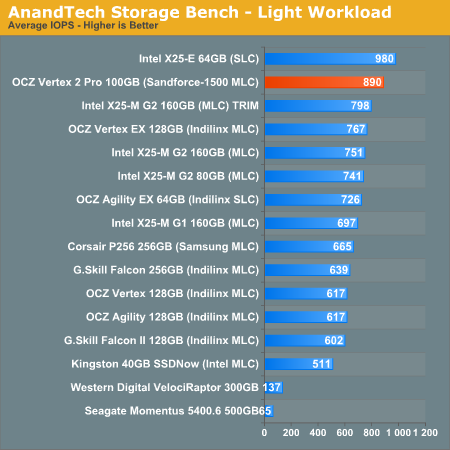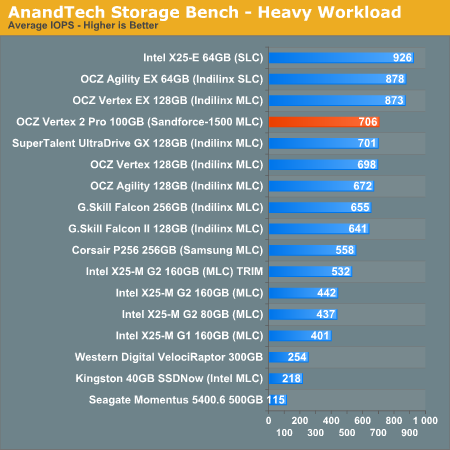OCZ's Vertex 2 Pro Preview: The Fastest MLC SSD We've Ever Tested
by Anand Lal Shimpi on December 31, 2009 12:00 AM EST- Posted in
- Storage
AnandTech Storage Bench
I introduced our storage suite in our last SSD article and it’s back, now with more data :)
Of the MLC SSDs represented here, there’s just nothing faster than the SandForce based OCZ Vertex 2 Pro.
Intel’s SLC based X25-E actually does very well, especially for a controller that’s as old as it is. It is worth noting however that the only thing separating Intel from SandForce-level performance is the X25-M’s low sequential write speed...
The first in our benchmark suite is a light usage case. The Windows 7 system is loaded with Firefox, Office 2007 and Adobe Reader among other applications. With Firefox we browse web pages like Facebook, AnandTech, Digg and other sites. Outlook is also running and we use it to check emails, create and send a message with a PDF attachment. Adobe Reader is used to view some PDFs. Excel 2007 is used to create a spreadsheet, graphs and save the document. The same goes for Word 2007. We open and step through a presentation in PowerPoint 2007 received as an email attachment before saving it to the desktop. Finally we watch a bit of a Firefly episode in Windows Media Player 11.
There’s some level of multitasking going on here but it’s not unreasonable by any means. Generally the application tasks proceed linearly, with the exception of things like web browsing which may happen in between one of the other tasks.
The recording is played back on all of our drives here today. Remember that we’re isolating disk performance, all we’re doing is playing back every single disk access that happened in that ~5 minute period of usage. The light workload is composed of 37,501 reads and 20,268 writes. Over 30% of the IOs are 4KB, 11% are 16KB, 22% are 32KB and approximately 13% are 64KB in size. Less than 30% of the operations are absolutely sequential in nature. Average queue depth is 6.09 IOs.
The performance results are reported in average I/O Operations per Second (IOPS):

If there’s a light usage case there’s bound to be a heavy one. In this test we have Microsoft Security Essentials running in the background with real time virus scanning enabled. We also perform a quick scan in the middle of the test. Firefox, Outlook, Excel, Word and Powerpoint are all used the same as they were in the light test. We add Photoshop CS4 to the mix, opening a bunch of 12MP images, editing them, then saving them as highly compressed JPGs for web publishing. Windows 7’s picture viewer is used to view a bunch of pictures on the hard drive. We use 7-zip to create and extract .7z archives. Downloading is also prominently featured in our heavy test; we download large files from the Internet during portions of the benchmark, as well as use uTorrent to grab a couple of torrents. Some of the applications in use are installed during the benchmark, Windows updates are also installed. Towards the end of the test we launch World of Warcraft, play for a few minutes, then delete the folder. This test also takes into account all of the disk accesses that happen while the OS is booting.
The benchmark is 22 minutes long and it consists of 128,895 read operations and 72,411 write operations. Roughly 44% of all IOs were sequential. Approximately 30% of all accesses were 4KB in size, 12% were 16KB in size, 14% were 32KB and 20% were 64KB. Average queue depth was 3.59.

Our final test focuses on actual gameplay in four 3D games: World of Warcraft, Batman: Arkham Asylum, FarCry 2 and Risen, in that order. The games are launched and played, altogether for a total of just under 30 minutes. The benchmark measures game load time, level load time, disk accesses from save games and normal data streaming during gameplay.
The gaming workload is made up of 75,206 read operations and only 4,592 write operations. Only 20% of the accesses are 4KB in size, nearly 40% are 64KB and 20% are 32KB. A whopping 69% of the IOs are sequential, meaning this is predominantly a sequential read benchmark. The average queue depth is 7.76 IOs.











100 Comments
View All Comments
Wwhat - Wednesday, January 6, 2010 - link
You make a good point, and anand seems to deliberately deflect thinking about it, now you must wonder why.Anyway don't be disheartened, your point is good regardless of this support of 'magic' that anad seems to prefer over an intellectual approach.
Shining Arcanine - Thursday, December 31, 2009 - link
As far as I can tell from Anand's description of the technology, it seems that this is being done transparently to the operating system, so while the operating system thinks that 25GB have been written, the SSD knows that it only wrote 11GB. Think of it of having two balancing sheets, one that other people see that has nice figures and the other that you see which has the real figures, sort of like what Enron did, except instead of showing the better figures to everyone else when the actual figures are worse, you show the worse figures to everyone else when the actual figures are better.Anand Lal Shimpi - Thursday, December 31, 2009 - link
Data compression, deduplication, etc... are all apparently picked and used on the fly. SandForce says it's not any one algorithm but a combination of optimizations.Take care,
Anand
AbRASiON - Friday, January 1, 2010 - link
What about data reliability, compressed data can normally be a bit of an issue recovering it - any thoughts?Jenoin - Thursday, December 31, 2009 - link
Could you please post actual disk capacity used for the windows 7 and office install?The "size" vs "size on disk" of all the folders/files on the drive, (listed by windows in the properties context tab) would be interesting, to see what level of compression there is.
Thanks
Anand Lal Shimpi - Thursday, December 31, 2009 - link
Reported capacity does not change. You don't physically get more space with DuraWrite, you just avoid wasting flash erase cycles.The only way to see that 25GB of installs results in 11GB of writes is to query the controller or flash memory directly. To the end user, it looks like you just wrote 25GB of data to the drive.
Take care,
Anand
notty22 - Thursday, December 31, 2009 - link
It would be nice for the customer if OCZ did not produce multiple models with varying degrees of quality . Whether its the controller or memory , or combination thereof.
Go to Newegg glance at OCZ 60 gig ssd and greeted with this.
OCZ Agility Series OCZSSD2-1AGT60G
OCZ Core Series V2 OCZSSD2-2C60G
OCZ Vertex Series OCZSSD2-1VTX60G
OCZ Vertex OCZSSD2-1VTXA60G
OCZ Vertex Turbo OCZSSD2-1VTXT60G
OCZ Vertex EX OCZSSD2-1VTXEX60G
OCZ Solid Series OCZSSD2-1SLD60G
OCZ Summit OCZSSD2-1SUM60G
OCZ Agility EX Series OCZSSD2-1AGTEX60G
219.00 - 409.00
Low to high the way I listed them.
I can understand when some say they will wait until the
manufactures work out all the various bugs/negatives that must
be inherent in all these model/name changes.
Which model gets future technical upgrades/support ?
jpiszcz - Thursday, December 31, 2009 - link
I agree with you on that one.What we need is an SSD that beats the X25-E, so far, there is none.
BTW-- is anyone here running X25-E on enterprise severs with > 100GB/day? If so, what kind of failure rates are seen?
Lonyo - Thursday, December 31, 2009 - link
I like the idea.Given the current state of the market, their product is pretty suitable when it comes to end user patterns.
SSDs are just too expensive for mass storage, so traditional large capacity mechanical drives make more sense for your film or TV or music collection (all of which are likely to be compressed), which all the non-compressed stuff goes on your SSD for fast access.
It's god sound thinking behind it for a performance drive, although in the long run I'm not so sure the approach would always be particularly useful in a consumer oriented drive.
dagamer34 - Thursday, December 31, 2009 - link
At least for now, consumer-oriented drives aren't where the money is. Until you get 160GB drives down to $100, most consumers will call SSDs too expensive for laptop use.The nice thing about desktops though is multiple slots. 80GB is all what most people need to install an OS, a few programs, and games. Media should be stored on a separate platter-based drive anyway (or even a centralized server).